|
Week 5: August 29 - September 4, 2012 |
Welcome
to the McGill Bird Observatory weekly report.
Click here for a complete listing of our archives.
Comments or
questions are welcome at "mbo AT migrationresearch.org".
|
PICTURE
OF THE WEEK: |
|
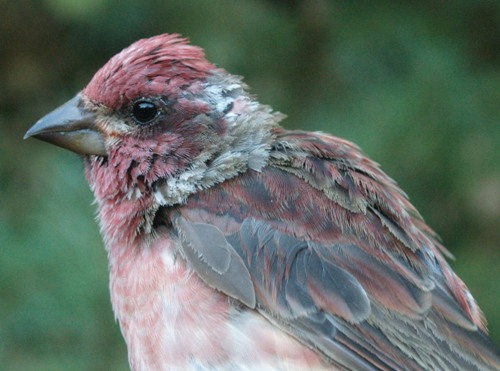
Purple Finches were the big surprise this week, with 9 individuals banded including
this second-year male part way through its prebasic molt.
(Photo by Simon Duval)
-
|
|
|
THIS WEEK |
THIS FALL |
2012 TOTAL |
SITE TOTAL |
|
# birds (and species) banded |
166 (36) |
1090 (60) |
2355 (81) |
38106 (108) |
|
# birds (and species) repeat |
52 (17) |
311 (31) |
649 (46) |
7062 (69) |
|
# birds (and species) return |
10 (8) |
41 (19) |
180 (27) |
1141 (38) |
|
# species observed |
78 |
114 |
159 |
207 |
|
# net hours |
504.8 |
2716.8 |
5976.6 |
65075.7 |
|
# birds banded / 100 net hours |
32.9 |
40.1 |
39.4 |
58.6 |
|
|
Note: table does not include nocturnal banding (owls) |
|
Banders-in-charge: Simon Duval, Gay Gruner
Assistants: Nicolas Bernier, Marc Boisvert, David Davey, Rui de Jesus, Réjean Duval, Louise Gagné, Monique Groulx, Alison Hackney, Lisa Keelty, Shelley Kirk, Patrick Laniel, Martin Lessard, Barbara MacDuff, Francine Marcoux, Betsy McFarlane, Ana Morales, Chris Murphy, Lisa Rosenberger, Catherine Russell, Carine Touma, Yifu Wang
Notes: The sunny weather largely continued this week, with only one day partly compromised by rain. However, whereas three of the previous four weeks provided a record number of birds banded, this week's total of 166 was actually below the long-term mean of 214, although the season total of 1090 is still ahead of the previous record by a slim margin. For the first time this season, diversity also slipped below average, with only 78 species observed over the course of the week.
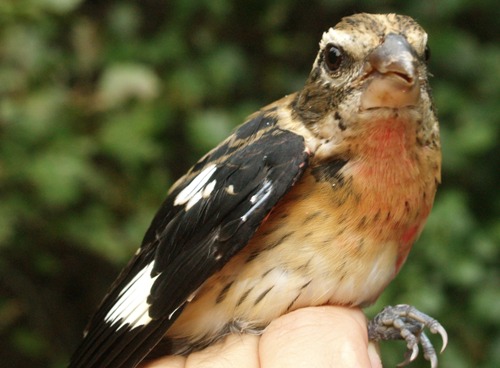
Continuing the molt theme, this week's birds included an after-second-year Rose-breasted Grosbeak above (looking quite different from its summer plumage already, but with all-dark primaries and secondaries), and the hatch-year Northern Cardinal below, just starting to get its red crest.
(Photos by Simon Duval)
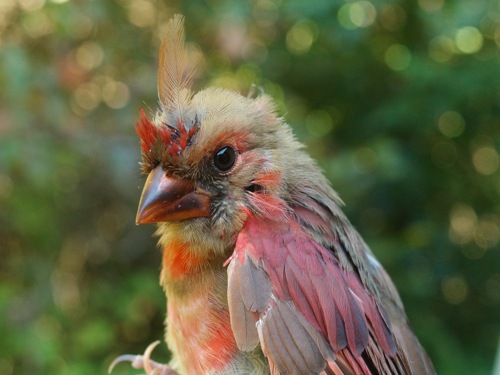
|
Heading into September, some new migrants arrive at MBO. This week's new arrivals were Ruby-crowned Kinglet, Orange-crowned Warbler, Northern Parula, and Lincoln's Sparrow, raising the season total to 114, still marginally ahead of any previous year at this time. Two of these species, the kinglet and the sparrow, were also banded for the first time this fall, as was Eastern Phoebe, which was new for the entire year. We also continue to increase our impressively high count of returns this fall, with the season total over one-third higher than in any previous year at this point. This week we had our first Blue Jay return of the season, and our first Warbling Vireo return of the year.
This week’s top 10 [last week's rank in brackets]
# individuals banded |
mean # individuals observed daily |
1. Magnolia Warbler (31) [1] |
1. Common Grackle (130) [1] |
2. Common Yellowthroat (11) [4] |
2. Canada Goose (28) [2] |
3. Red-eyed Vireo (10) [7] |
3. Black-capped Chickadee (19) [5] |
3. American Redstart (10) [2] |
4. American Goldfinch (19) [4] |
3. White-throated Sparrow (10) [-] |
5. American Crow (18) [9] |
6. Purple Finch (9) [-] |
6. Blue Jay (17) [6] |
7. Northern Waterthrush (8) [-] |
7. Cedar Waxwing (13) [3] |
7. Tennessee Warbler (8) [3] |
8. Ring-billed Gull (10) [-] |
7. Chipping Sparrow (8) [-] |
9. White-throated Sparrow (10) [-] |
10. Swainson's Thrush (7) [-]
|
10. American Robin (10) [7] |
|
For the eighth year in a row, Magnolia Warblers dominated our banding counts in week 5 of the Fall Migration Monitoring Program. Although the 31 individuals banded this week is a bit below the long-term average of 41 for this time of year, it was still enough to claim top spot by a wide margin over runner-up Common Yellowthroat, which we banded in double digits for the fifth straight week. Red-eyed Vireo was among a trio of species tied for third place, the third time in our eight fall seasons that it has ranked this high in week 5. Also in that tie was American Redstart, now with 119 individuals banded this season, just behind the overall leader, Song Sparrow. Rounding out the tie was White-throated Sparrow, a species usually not ranking this high until later in September. The biggest surprise though was Purple Finch, with more individuals banded this week than in any entire previous season except fall 2007, when we had a total of 11. We had our best weekly count of Northern Waterthrush yet this season, with 8 individuals as part of another three-way tie, also including a reduced number of Tennessee Warblers, and a new influx of Chipping Sparrows. Rounding out the list was another uncommon visitor to the top ten, Swainson's Thrush. With five new entries to the top ten this week reflecting the mid-season shift in migrants, those that dropped down the list from last week were Song Sparrow, Rose-breasted Grosbeak, Ovenbird, Indigo Bunting, Black-capped Chickadee, and Gray Catbird.
Common Grackle retained a stranglehold on species observed, with on average over 100 individuals more per day than Canada Goose in second place. Both of those species stayed in the same positions as last week, as did American Goldfinch in fourth spot, while Black-capped Chickadee shifted into the top three, even though their mean daily count dropped from 31 last week to 19 this week. Rounding out the top five was American Crow, followed closely by a continued good movement of Blue Jays. Cedar Waxwing numbers are finally tapering off, and American Robins are just barely clinging to the top ten, while Ring-billed Gull and White-throated Sparrow numbers increased just enough to make this week's highlights. This is only the second time that White-throated Sparrow has cracked the top ten in week 5; the previous time in 2006 we ended up with our lowest ever season total for the species, so it will be interesting to see whether that pattern repeats over the remainder of this fall. Consistent with the lower number of Song Sparrows banded this week, fewer were also observed, and they dropped out of the top ten, along with Red-winged Blackbird - a bit of a surprise, in that they often are part of mixed blackbird flocks in fall, but so far appear to be largely absent from the large grackle flocks, which this week ranged from 48 to 305 daily.
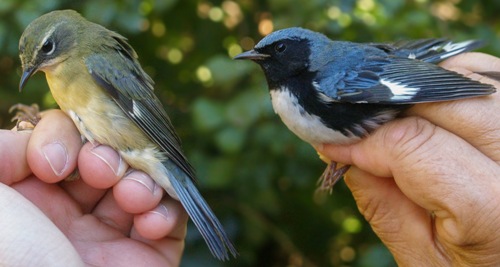
One of the few warbler species in which the sexes are easily separable in fall, Black-throated Blue Warbler.
(Photo by
Simon Duval) |
It was around this time last fall that numbers began to taper off, and the pace of migration never really recovered to the extent we have become used to in previous years. Were this week's results a sign that we are heading down the same path, or is this just a small breather before a much busier peak of migration in the weeks ahead? We'll soon see whether week 6 holds any hints in that regard.
|
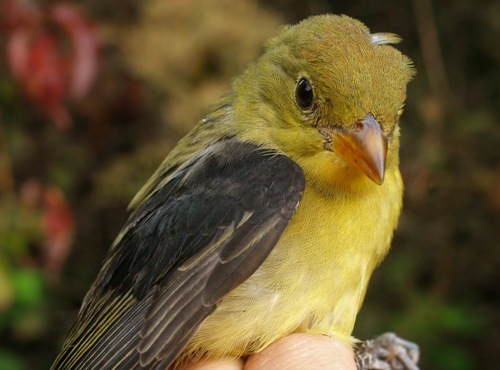
Rounding out this week's photos illustrating molt, the hatch-year Scarlet Tanager above shows a distinct limit on the wing between its brown juvenile feathers and replaced blackish preformative feathers, while the female Indigo Bunting below is in the midst of its prebasic molt, with some of its old and worn primaries and secondaries contrasting with the darker new basic feathers.
(Photos by Simon Duval)
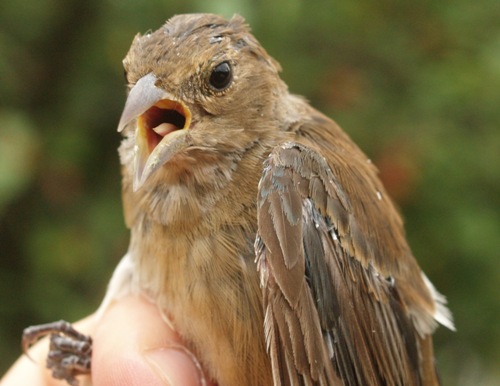

Although the long run of dry weather has been great for operating our daily program, it has taken a toll on our ponds - this is about as dry as we've ever seen the back pond at this time of year, and we have to hope there will be some replenishment eventually.
(Photo by
Gay Gruner)
|







